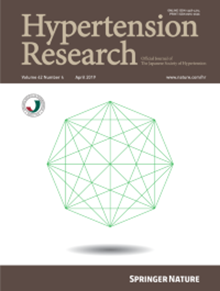A prospective analysis to assess the multifactorial risk of childhood-onset hypertension: the ExAMIN Youth SA study
IF 4.6
2区 医学
Q1 PERIPHERAL VASCULAR DISEASE
引用次数: 0
Abstract
Childhood-onset hypertension tracks into adulthood and is on the rise globally. Identifying risk factors in early childhood remains of epidemiological importance for developing early intervention and prevention strategies to mitigate premature hypertension onset. This study explored the changes in blood pressure and the predictive value of individual and composite baseline risk factors for elevated blood pressure over a 4-year period in South African children. We included 767 healthy children (aged 5–9 years at baseline) with a mean follow-up time of four years. Office blood pressure, anthropometry, cardiorespiratory fitness, health-related quality of life, food intake and urinary biomarkers were measured. Children were stratified by blood pressure status according to the 2017 American Academy of Pediatrics guidelines. Individual baseline risk factors as well as composite risk factors were assessed to predict follow-up blood pressure status. The prevalence of elevated blood pressure declined by 6% over four years. Longitudinally, age (HR:1.78; p = 0.005), ethnicity (HR:0.048; p = 0.001), socioeconomic status (HR:0.42; p = 0.004) and sugar-sweetened beverages intake (HR:1.67; p = 0.026) predicted elevated blood pressure over four years. No significant results were observed with composite risk factors cross-sectionally, however factor pattern 1 (socioeconomic status, family history, meat and milk product intake) indicated a lower risk of elevated blood pressure at follow-up (HR:0.74; p = 0.042). Multiple risk factors, including diet and socioeconomic status, contribute to elevated blood pressure in South African children. Early multifaceted interventions targeting these factors are essential to prevent long-term cardiovascular disease.

一项评估儿童期高血压多因素风险的前瞻性分析:ExAMIN Youth SA研究。
儿童期发病的高血压会进入成年期,并且在全球范围内呈上升趋势。确定儿童早期的危险因素对于制定早期干预和预防策略以减轻高血压过早发作仍然具有流行病学意义。本研究探讨了南非儿童4年期间血压的变化以及个体和复合基线危险因素对血压升高的预测价值。我们纳入了767名健康儿童(基线年龄5-9岁),平均随访时间为4年。测量办公室血压、人体测量、心肺健康、健康相关生活质量、食物摄入和尿液生物标志物。根据2017年美国儿科学会的指南,儿童按血压状况分层。评估个体基线危险因素以及复合危险因素以预测随访血压状况。高血压的患病率在四年里下降了6%。纵向上,年龄(HR:1.78;p = 0.005)、种族(HR:0.048;p = 0.001)、社会经济地位(HR:0.42;p = 0.004)和含糖饮料摄入量(HR:1.67;P = 0.026)预测4年内血压升高。综合危险因素在横断面上没有观察到显著的结果,但因素模式1(社会经济地位、家族史、肉类和奶制品摄入量)表明随访时血压升高的风险较低(HR:0.74;p = 0.042)。多种风险因素,包括饮食和社会经济地位,导致南非儿童血压升高。针对这些因素的早期多方面干预对于预防长期心血管疾病至关重要。
本文章由计算机程序翻译,如有差异,请以英文原文为准。
求助全文
约1分钟内获得全文
求助全文
来源期刊

Hypertension Research
医学-外周血管病
CiteScore
7.40
自引率
16.70%
发文量
249
审稿时长
3-8 weeks
期刊介绍:
Hypertension Research is the official publication of the Japanese Society of Hypertension. The journal publishes papers reporting original clinical and experimental research that contribute to the advancement of knowledge in the field of hypertension and related cardiovascular diseases. The journal publishes Review Articles, Articles, Correspondence and Comments.
 求助内容:
求助内容: 应助结果提醒方式:
应助结果提醒方式:


